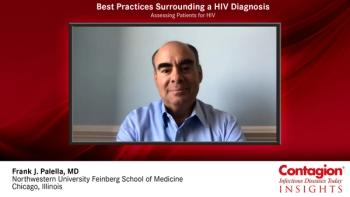
Selecting a Novel Combination Regimen as HIV Treatment
The potential role of novel 2-drug regimens as treatment for HIV infections, and variables that impact a physician’s willingness to utilize over standard 3-drug options.
Episodes in this series

Frank J. Palella, MD: The landscape surrounding the traditional gold standard 3-drug regimens vs evolving information regarding 2-drug therapy, which is a second-generation integrase inhibitor along with usually lamivudine 3TC or FTC [emtricitabine], is that for many patients, 2-drug therapies are an option as long as we have a good assessment of transmitted or preexisting drug resistance in terms of the virus. This means mutations in the virus that would render certain drugs less active, as long as we have a good characterization. That’s why any time we initiate therapy for HIV, we always get a pretherapy genotype or resistance test to evaluate and verify the therapies that we want to use to treat HIV, including 3-drug or 2-drug regimens, are going to be fully effective.
The standard is that we need to have at least 2 fully active drugs acting against the treatment. However, if there is any transmitted or on-treatment emerging resistance that might compromise a drug, with a 2-drug regimen it becomes even more imperative that we verify the full activity of those 2 drugs. With the 3-drug regimen, it’s a little easier to do. That being said, there are many proponents of 2-drug regimens because it’s 1 less drug. And in terms of cost, in terms of avoidance of potential drug-related toxicity, there are perceived to be potential benefits.
On the other side, in a world where most of the therapies that we use in the front line are in fixed-dose combination single-tablet regimens, from the patient’s point of view, if that single pill they’re taking per day has 2, 3, or 4 drugs, it doesn’t make a big difference to them. From an adherence point of view and a patient acceptability point of view, it might not make a big difference. Whether 2- vs 3-drug regimens matter in terms of overall efficacy and virologic suppression, the data we have suggests that for most people without preexisting resistance, it might not make a big difference.
However, there’s a theoretical concern that’s increasingly being debunked. For persons who initiate HIV with the highest pretherapy viral loads, many hundreds of thousands or even millions, would we be better off with the 3-drug regimen? The data that we have attesting to this is not robust because we don’t have evidence from clinical trials involving many patients with extremely high viral loads who’ve been put on 2-drug therapy. But this is an evolving scenario.
Regarding the acceptability on the part of prescribers for 2-drug therapy, let’s keep in mind that over the last 25, 26 years, during the era of highly active antiretroviral therapy, such therapy was defined by the presence of 3 drugs: initially a protease inhibitor and 2 nucleoside or nucleotide reverse transcriptase inhibitors, then non-nucleosides plus 2 nucleosides again, then boosted protease inhibitors and integrase inhibitors. For the gold standard, the paradigm has been, and to a large extent remains, a 3-drug regimen including 2 nucleosides and either a boosted protease inhibitor, a non-nucleoside reverse transcriptase inhibitor, or an integrase strand transfer inhibitor.
Regimens that seek to modify that paradigm are always going to be greeted with some circumspection on the part of the provider. They will wonder whether such newer types of 2-drug regimens can stack up in all the ways that we traditionally have associated with 3-drug regimens, hence the need. It’s been done to a large extent, for randomized clinical trials, blinded, that compare standard 3-drug regimens to more novel 2-drug regimens. That evidence-based medicine is necessary for prescribers to feel comfortable. Likewise, prescribers need to feel comfortable prescribing such regimens across an array of patient types: age, race, sex, comorbidities, geographic areas, disease, stage of HIV, low CD4s, and high viral loads. It’s gradual over time in a real-world setting, providers achieving a comfort level with 2-drug regimens across diverse patient types.
Transcript edited for clarity.
Newsletter
Stay ahead of emerging infectious disease threats with expert insights and breaking research. Subscribe now to get updates delivered straight to your inbox.















































































































































































































































































